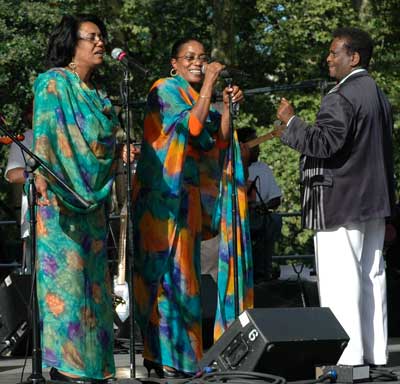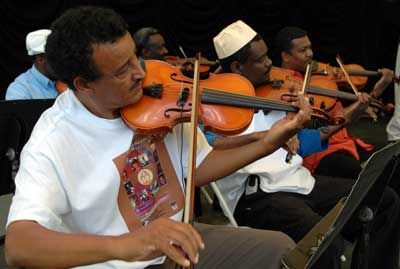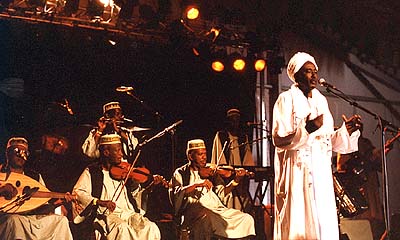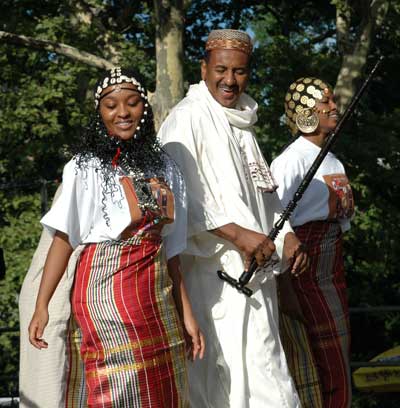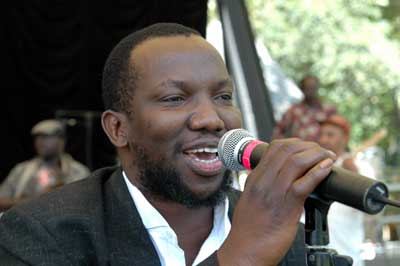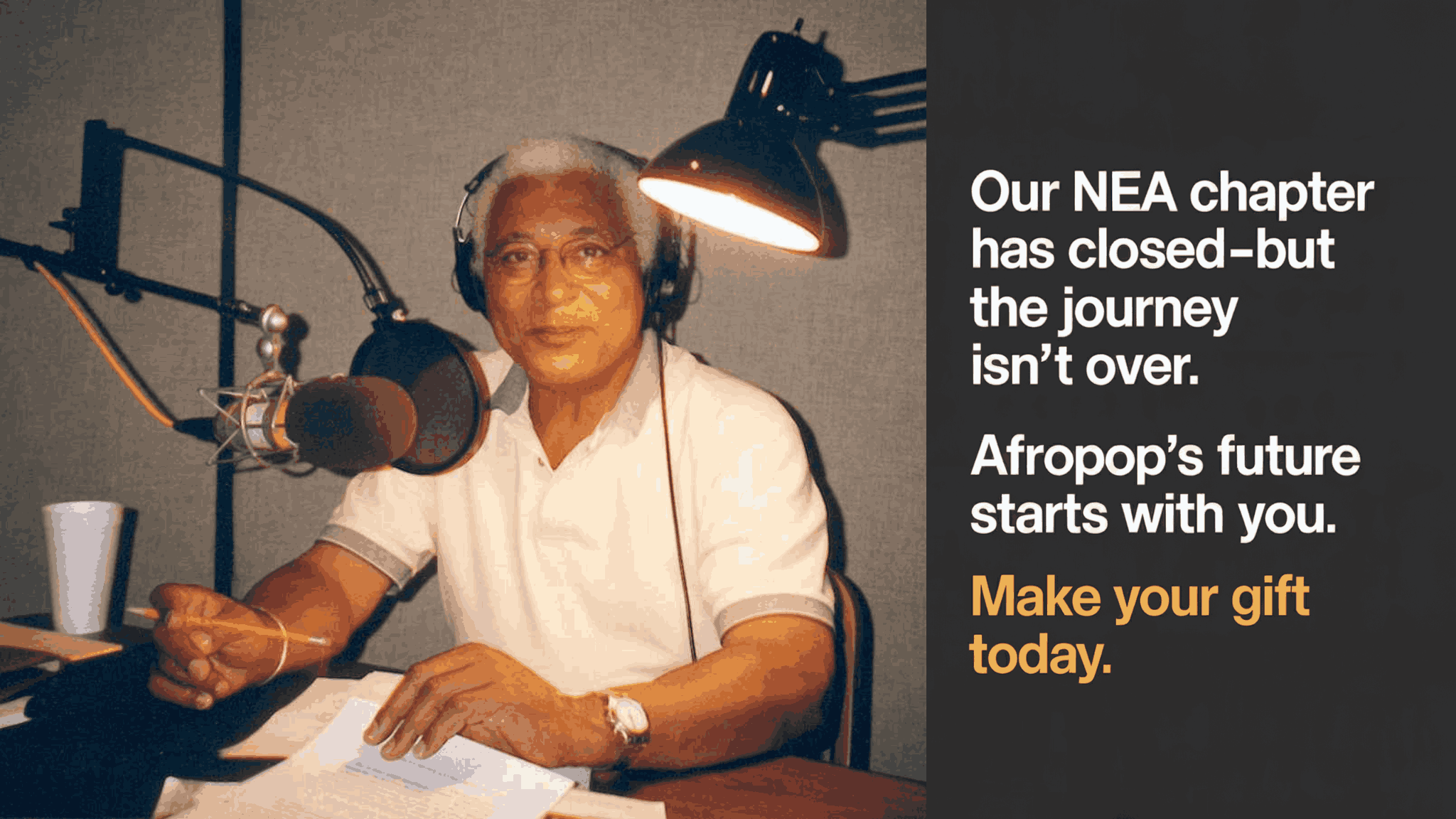Click here for Afropop’s review of the 2007 Sudan Festival of Music and Dance.
The Sudanese Music and Dance Festival is a summit of superb singers, dancers and instrumentalists who believe that by bringing together their diverse arts, they can point the way to a peaceful and productive future for Sudan. In its second year, this festival will present a magnificent tableau of top-flight performers representing many regions of this unique African nation. These artists’ experience and virtuosity is matched by their passion, for their performances are literally aimed at changing the course of history.
Omer Ihsas of Darfur (Eyre 2007)
Featured artists in the 2008 festival include veteran singers Abdel Gadir Salim, Abu Araki Al Bakheit, Omar Banaga Amir, and Ali Alsigaid. The legendary, female vocal group Al Balabil represents the ancient, northern kingdom of Nubia;
Omer Ihas represents Darfur; the rapper Dynamq and also popular singer/guitarist/songwriter John Kudusay represent southern Sudan; Mohammad Adaroab represents the eastern region; and Rasha represents progressive trends in the Sudanese diaspora in Europe. All the performances will be accompanied by The Nile Music and Dance Orchestra, an amalgam of top-flight players from throughout Sudan’s worldwide diaspora, all under the direction of one of Sudan’s most established composers and producers, Yousif El Mosley. As a crowd-pleasing bonus, NBA Basketball star and social activist Manute Bol—who was born in Sudan—will share the stage with these extraordinary artists in their Chicago show.
The artists gathering this summer have lived the diverse and troubled history of Sudanese music. During the 1960s and 70s—often called “the golden era” of Sudanese music—fascinating musical hybrids of African, Arab, and European music flourished in Sudanese cities, especially in the cities of Khartoum and Omdurman, home of the national radio and television station, but also Juba in the south and elsewhere.
Among the most remarkable golden era acts to appear in this year’s festival are the three singing sisters known as Al Balabil.
Al Balabil
In the early ‘70s, this trio of talented, musically trained teenagers became Khartoum’s answer to the Supremes, and they revolutionized social and artistic possibilities for Sudanese women. With the rise of Islamism after 1989, the doors Al Balabil opened for women began to close. The three sisters married, then separated, two leaving Sudan and one remaining in the country. For the past 22 years, circumstances in Sudan have made it virtually impossible for the three to perform together, so their reunion this summer will be historic, especially for young Sudanese expatriates who have grown up knowing of this legendary group, but have never seen them perform.
Singers like Abu Araki al-Bakheit and Ali Alsigaid came up in the orchestral tradition of the north, long the dominant force in commercial music. Like many of their peers and successors, these vocal stars studied at the prestigious Institute of Music and Drama in Khartoum. The music they championed bears similarities to Egyptian orchestral music, and even the taarab orchestras of Tanzania and Kenya. But while much of the instrumentation and aesthetics were borrowed from Arab and European sources, the music itself relied on distinctly Sudanese rhythms, scales and melodies. As Sudanese music developed, talented artists came from different regions of the country to introduce new ideas and colors to the national sound, effectively building a kind of unity that has evaded politicians.
Abdel Gadir Salim and his group (2002-Eyre)
Abdel Gadir Salim introduced the traditions of Kordofan in the west, and became one of the country’s most beloved singers and bandleaders. Like Mohammed Wardi before him, Salim brought influences from international jazz and pop as well—electric guitars, keyboards, and saxophone, side by side with the oud, violins, and traditional percussion.
Omer Ihsas of Darfur (Eyre 2007)
Omer Ihsas charted a similar course bringing in the traditions of his native Darfur, which borders Libya, Chad, and Central African Republic and is home to a dazzling array of local music and dance. Ihsas modernized these styles and made them accessible to all Sudanese. A champion of eastern Sudanese music, Mohammad Adaroab, will also be present the music of the Bija and other eastern tribes, performed on oud, tambour (hand drum) and rababa (bowed lute).
Yousif El Moseley of Sudan (Eyre 2007)
The musical director for the Sudanese Music and Dance Festival, Yousif El Moseley, moved from singing traditional songs with percussion to composing for and performing with wedding bands in 1970s Khartoum. As a star student, and then an instructor, at the Institute of Drama and Music, El Mosley earned the chance to travel to Cairo, where he attained a Masters degree in composition. When he returned to Khartoum in 1989 modernity was in the air. The amazing Al Balabil had hit the scene with their electrifying performances of familiar Sudanese styles, but also, the distinct music and sensibility of their ancestral homeland, Nubia. Music and social life were advancing hand in hand as Sudan broached a new era.
All of this progress was cut short after the 1989 coup. Life became extremely difficult for artists. There was an 11PM curfew, and popular figures like El Mosley and Abu Araki faced pressure to sing for the regime. Both refused and suffered the consequences. Abu Araki tried to retire rather than cooperate, but his fans wouldn’t let him stop, and he was harassed and threatened often as government minders scanned even his love songs for subversive messages. El Mosley returned to Cairo, where he became a successful producer for Hassad Productions, the biggest production house for Sudanese music ever. Between 1992-96, El Mosley recorded 45 albums featuring the top Sudanese singers of the day. From Cairo, Yousif El Mosley moved to the United States in 1996, and he now teaches in Monterrey, California. A number of great artists from El Mosley’s generation have also come to the U.S., including musicians with whom he made his classic recordings. Many of these will join the Nile Music and Dance Orchestra this summer.
Omar Banaga and dancers (Eyre 2007)
Among the most socially engaged groups of the 90s was Igd al Djilad, featuring composer and singer Omar Banaga Amir, another participant in the 2008 festival. Igd al Djilad’s early songs focused on the suffering of ordinary people under the regime, and the group incurred the government’s wrath on many occasions. There are horrifying stories of music and musicians in Sudan since 1989. Irreplaceable manuscripts and recordings appear to have been lost or destroyed. Musicians have been beaten, even murdered, and over 200 of the most beloved performance artists have, like El Mosley, Omar Banaga, and Mohammed Mergani, gone into exile. Some Sudanese artists, like the young singer/songwriter Rasha Sheikh Aldein, have moved to Europe. Rasha has made a promising career interpreting Sudanese tradition in her own ways, bringing in influences from jazz, pop, and world music, and delivering powerful social commentary.
Emmanuel Kem
The music of southern Sudan has had a particularly hard time developing and reaching the world. In the past, southern Sudanese music, which takes influence from the neighboring musical powerhouse in Congo, was rarely well recorded or disseminated. But in recent years, young rappers have brought new attention to the region with international careers based abroad. Rapper Emmanuel Jal’s collaboration with Abdel Gadir Salim, Ceasefire (2005) was a landmark in this developing story. The Sudanese Festival features another young rapper from the south who is making waves around the world and gaining star status back home. Dynamq, known by fans as “Sudanese Child,” first came to prominence as a singer and soccer player among the Sudanese refugee community in Kenya. In recent years, he has shared stages with top names in international reggae and hip-hop. His appearance on stage with great musicians from the north will be another historic feature of this summer’s performances. The Chicago concert will also make history for the inclusion of the southern Sudanese expatriate best known to Americans, basketball star Manute Bol.
Although the artists in the Sudanese Festival of Music and Dance come from different locations, ethnic backgrounds, generations, and experience, they share one vision: to see their country peaceful and united. Their presence on one stage will not only be an unprecedented summit of Sudan’s greatest living musical talent, and an emotionally charged reunion for the participants, but most of all, a powerful symbol of what could be possible back home. This will be a true life example of musicians pointing the way to a better world.








